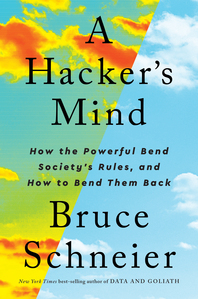A Hacker’s Mind: How the Powerful Bend Society’s Rules, and How to Bend them Back
by Bruce Schneier
Norton
ISBN: 978-0-393-86666-7
One of the lessons of the Trump presidency has been how much of the US government runs on norms that have developed organically over the republic’s 247-year history. Trump felt no compunction about breaking those norms. In computer security parlance, he hacked the system by breaking those norms in ways few foresaw or thought possible.
This is the kind of global systemic hacking Bruce Scheneir explores in his latest book, A Hacker’s Mind. Where most books on this topic limit their focus to hacking computers, Schneier opts to start with computer hacking, use it to illustrate the hacker’s habit of mind, and then find that mindset in much larger and more consequential systemic abuses. In his array of hacks by the rich and powerful, Trump is a distinctly minor player.
First, however, Schneier introduces computer hacking from the 1980s onward. In this case, “hacking” is defined in the old way: active subversion of a system to make it do things its designers never intended. In the 1980s, “hacker” was a term of respect applied to you by others admiring your cleverness. It was only in the 1990s that common usage equated hacking with committing crimes with a computer. In his 1984 book Hackers, Steven Levy showed this culture in action at MIT. It’s safe to say that without hacks we wouldn’t have the Internet.
The hacker’s habit of mind can be applied to far more than just technology. It can – and is today being used to – subvert laws, social norms, financial systems, politics, and democracy itself. This is Schneier’s main point. You can draw a straight line from technological cleverness to Silicon Valley’s “disrupt” to the aphorism coined by Georgetown law professor Julie Cohen, whom Schneier quotes: “Power interprets regulation as damage, and routes around it”.
In the first parts of the book he discusses the impact of system vulnerabilities, the kinds of responses one can make, and the basic types of response. In a compact amount of space, he covers patching, hardening, and simplifying systems, evaluating threat models as they change, and limiting the damage the hack can cause. Or, the hack may be normalized, becoming part of our everyday landscape.
Then he gets serious. In the bulk of the book, he explores applications: hacking financial, legal, political, cognitive, and AI systems. Specialized AI – Schneier wisely avoids the entirely speculative hype and fear around artificial general intelligence – is both exceptionally vulnerable to hacks and an exceptional vector for them. Anthropomorphic robots especially can be designed to hack our emotional responses.
“The rich are better at hacking,” he observes. They have greater resources, more powerful allies, and better access. If the good side of hacking is innovation, the bad side is societal damage, increasing unfairness and inequality, and the subversion of the systems we used to trust. Schneier believes all of this will get worse because today’s winners have so much ability to hack what’s left. Hacking, he says, is an existential threat. Nonetheless, he has hope: we *can* build resilient governance structures. We must hack hacking.
